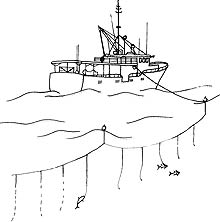Longlines
These are one line that can be several kilometres long. Baits are attached to the line at regular intervals as it is being set from a moving boat. Longlines can be set at various depths in the water. Shark fishers generally set their lines on the sea floor with anchors to keep the line in place. Tuna fishers set their lines above the seafloor and although they do not target sharks they catch a lot as bycatch.
Trawling
Trawlers tow a net along the seabed. Trawlers usually target fish and prawns rather than sharks; however, they can be caught in high numbers as bycatch. Bycatch has been reduced by using special equipment that allows large animals to escape from the net. |

Pelagic longline vessel with line deployed
(© Bureau of Rural Sciences, Australian
Fisheries Resources, 1993) |
